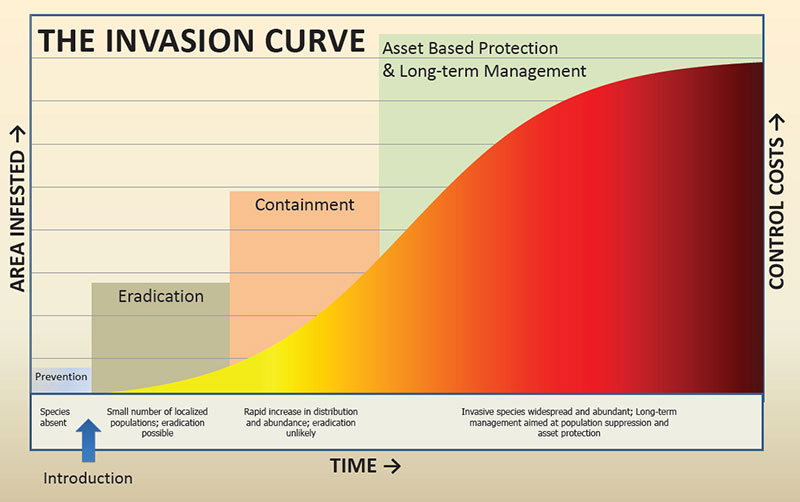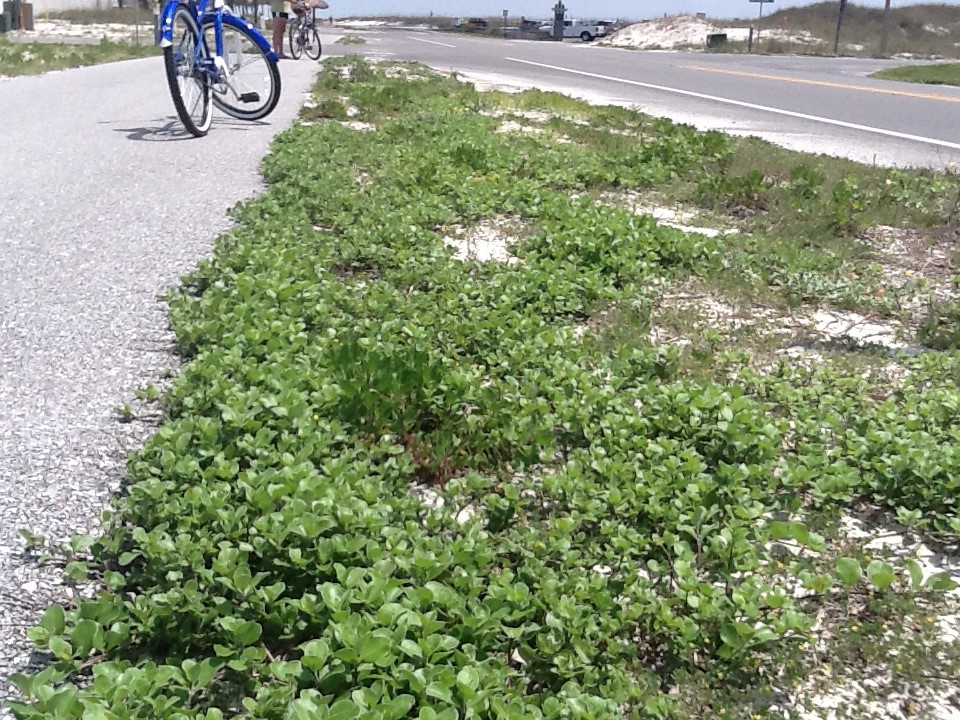If you read the introduction article to this series you would know that yes – based on comments from Dr. Simberloff, we can. But your best chance at doing so is when the species is early in its invasion of the area – Early Detection Rapid Response (EDRR). This can be seen again on the invasive species curve (pictured below).

Have we jumped on the beach vitex issue quick enough?
I am not sure. Based on the records provided to EDDMapS (www.EDDMapS.org) there are 677 records in the United States. 97 of those are in Florida. 80 are in the Florida panhandle with another 5 records in Baldwin County AL. 44 of those records are in the Pensacola Bay area, another 34 in the Choctawhatchee Bay, and 5 records near Apalachicola. This certainly sounds doable. There are not that many records, and we should be able to easily remove plants from 80 sites. However, I am also certain this is much underreported. In my spreadsheet from our local surveys in the Pensacola Bay area I have 97 records – over double what EDDMapS has reported – and you could assume the same for the others.
From EDDMapS, in the Pensacola Bay area there are three records from Perdido Bay, one from NAS Pensacola, 18 from Pensacola Beach, 3 from Navarre Beach, and 22 from Gulf Islands National Seashore. Within Gulf Islands 20 of these are from Naval Live Oaks, 1 from Ft. Pickens, and 1 from Opal Beach.
From my survey records I have 3 records from Gulf Breeze, 2 from Perdido Bay, 2 from Perdido Key, 7 from Navarre, 26 from Gulfs Islands National Seashore, and 57 from Pensacola Beach. I should add here that 1 of the 3 in Gulf Breeze, 1 of the 2 in Perdido Bay, and 25 of the 57 on Pensacola Beach are currently “green” on my spreadsheet indicating that have been treated, removed, and have not returned (“eradicated”) – that is 28% of the known records – 70 records (72%) are still out there.
When you look at the Choctawhatchee Bay area, 32 of the 34 records are on Eglin AFB property and are being controlled. I am not sure how many have been eradicated, but they know where they are and are on top of the problem. Two additional records are in Okaloosa County proper, one on Hwy 98 between Ft. Walton and Destin, the other in Henderson State Park near Destin. Likewise, I am not sure of the status of these two sites. Further east there is a record in Gulf County, and four in Franklin County.
These numbers suggest that yes… we have jumped on this plant soon enough and that eradication is possible. But… do we have all of the records? Are there really only these in the counties reported? Are there no plants in Walton and Bay counties? One would feel that there are more out there.

Step 1 – we need GOOD surveys conducted.
To date, all of the records have been coastal along the Intracoastal Waterway. The seeds are viable in saltwater for up to six months. Any seed that makes into the ICWW can easily be dispersed to new locations. But it will take diligent work from community partners to survey these areas and update all of the records. If interested in doing a survey, let me know.
Step 2 – treatment.
When treating invasive plants there are three methods you can choose. (1) biological, (2) mechanical, and (3) chemical. Currently, there are no biological controls for beach vitex approved by the Department of Agriculture, and I am not aware of any studies testing one. So… this is not an option at the moment. Many prefer not to use herbicides and that means mechanical removal. There are plenty of records in the Pensacola Beach area where this has been successful. In each case the plants where young, herbaceous vines and we could easily pull the taproot out. In some cases, we did have to dig to remove all of the plant, but – based on annual surveys after treatment – they have not returned. But in many cases mechanical removal was not an option due to the depth of the taproot, the extent of secondary roots extending from the spreading stolons, or the sheer mass and area in which the plant had invaded. As beach vitex grows it becomes woodier, and more of a shrub with extending vines running in all directions. At this stage you will need chemical.
Based on studies conducted at Clemson University, the most effective chemical herbicides are those with the active ingredient IMAZAPYR. This chemical showed success within one year in many cases but has its problems. (1) The chemical is non-select, many it will kill any plant it comes in contact with – and they could be very undesirable. (2) it has a long soil activity life – meaning it is active in the soil for several months. Nothing will grow in the location and re-planting with native plants could be unsuccessful. TRICLOPYR is a chemical used for Chinese Tallow and Poison Ivy. It seems to be very effective on beach vitex however, it too is non-select and though its soil activity is not as long as imazapyr, there is a period of time when re-planting will not be successful. A third chemical tested was GLYPHOSATE. This product is also non-selective but its soil activity is only a few days, allowing from re-planting within a week. However, because it is not as effective as the previous chemicals, re-treatments each year may be required (one study suggested up to five years of re-treatment may be needed).
The chemical we are currently using is glyphosate. Though it does mean that many of our records have not been eradicated yet, we can re-plant with native plants very soon and this has been desirable for a variety of reasons. You must be careful to reduce over spray so that you do not kill neighboring plants. In most cases, we remove all of the above ground biomass and then cut and treat the taproot. Returning the following year to see how it has done. NOTE: the seeds are numerous and working with the plant while it is in seed could spread the problem. It is in seed during the fall and winter. We recommend waiting until spring to do removals and summer to do chemical treatments.
Step 3 – monitoring.
It is important to re-visit each site (even it has been gone for over a year) to assess the status of these plants. I am not sure how long seeds can be active in the soil. There is a chance that though the plant you were working on was eradicated, the seeds it left the season before may sprout and re-treatment needed.
YES – it is a lot of work, a lot of time, a lot of resources to manage invasive species. Here again, finding the problems early and putting together a management plan can make the possibility of eradication possible and at a lower price. Based on EDDMapS, there are four other records in the Jacksonville area. If this is truly all there is out there, then we can – and should – eradicate this plant from the state. But…
Let’s start with step 1 and go from there.
If your community is interested in forming a survey/management team and needs help doing so, let me know. We will do everything we can to make it effective and hopefully remove this plant from our area.
- Tips for Bear Encounters this Fall - November 10, 2025
- Pensacola Bay Invasive Species Summer Survey 2025 - November 3, 2025
- Our Environment: Part 24 – Our Changing Climate - November 3, 2025
